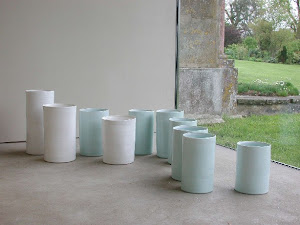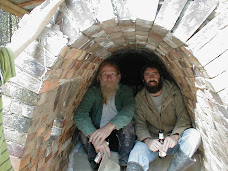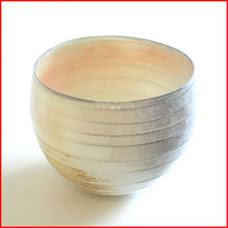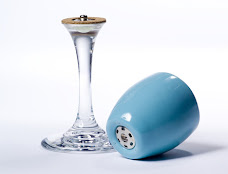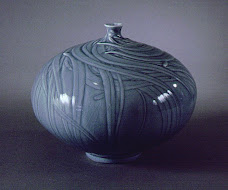'''Jane Reumert'''
Jane Reumert was born in Denmark in 1942. Reumert has spent more than 40 years as a professional studio ceramist. She is one of Denmark’s most respected artists, and she has gained much international recognition. She began as many potters do working with stoneware clay, and making functional pottery. http://www.pulsceramics.com Over the course of her career, her dedication to the process and the material has given her an understanding and touch that is skilled and unique. In other professions, her tireless testing and questioning would most likely be called research. People in the visual-arts world do not usually consider their artwork to be research, but I it is hard to call her relentless investigation anything else.
Jane made changes to her work as it developed and matured into what it is today, though she has always sought to make vessels which were simple, and close to nature. Reumert’s work has many influences, but nature and calligraphy are “deep-rooted sources of inspiration”. In an interview she stated that as a child she was captivated with nature, with birds – and their nests, feathers and eggs. This acute observation of nature, especially of birds, is shown clearly in some of her more contemporary works that mimic eggs and feathers of birds. Bodil Busk Laurensen, "Jane Reumert's Fidelity to Ceramics," Ceramics: Art and Perception, No. 62, 2005, pp. 20-24. She has also mastered the art of calligraphy, and uses lettering styles from the East to the West.
After working on throwing and glazing techniques for more than thirty years her thoughts and practices took an interesting turn. She began to strive for translucency, and thin, refined beauty. In the late 1980’s she began working in porcelain clay, which can be translucent when it is thin and fired to very high temperatures. She began making paper-thin vessels, salt glazed, and fired to 1330 degrees Celsius (above 2300 F). In the early 1990s she began experimenting with the addition of fiberglass and other fibers added to her clay body, which enabled her to construct even thinner and bigger translucent forms. Her “eggshell” and “feather” vessels are so thin and light they seem to be from another world. She often displays her work on wire tripods, so the vessels appear to be floating above their shadows.http://www.pulsceramics.com Reumert’s work is a great metaphor of the fragility of our existence.
She has shown internationally, and has been awarded prizes for her work. Among these, in 1994, she was awarded Scandinavia’s most prestigious design prize: the Torsten and Wanja Soderberg Nordic Design Prize.Bodil Busk Laurensen, "Jane Reumert's Fidelity to Ceramics," Ceramics: Art and Perception, No. 62, 2005, pp. 20-24. Reumert has published writings and books on ceramic techniques, as well as on her own work. She writes in Danish, but some of her books have been translated into other languages. Examples of these are her two books, Transparency, and Contemporary Pottery. Recently Reumert has moved away from her home and studio on the island of Bornholm. She is now living and working close to Copenhagen. She is now using a wood-fired kiln, and has chosen to change from salt firings to soda firings, which are a bit more environmentally friendly. http:pulsceramics.com Just this past summer she took part in the Nordic Woodfire Marathon, and was a guest artist at the International Ceramic Research Center in Denmark.http:woodfiremarathon2007.blogspot.com
Links:
http://www.carlakoch.nl/
http://www.carlakoch.nl/kunstenaars/jreumert.html - images
http://www.ceramic.dk/
References:
Bodil Busk Laurensen, “Jane Reumert’s Fidelity to Ceramics,” ''Ceramics: Art and Perception'', No. 62, 2005, pp. 20-24.
http://woodfiremarathon2007.blogspot.com/
http://www.pulsceramics.com/janereumert.html
Wednesday, October 31, 2007
Wednesday, October 24, 2007
the way of tea
To witness the Tea Ceremony, even if it was an instructional version, was wonderful. I respect how even in contemporary Japanese culture people are connected to tradition. The ceramic vessel has been used and admired in everyday life in Japan for thousands of years. The Tea Ceremony is a codified practice, which has evolved throughout the centuries, but it still hold true to the original intentions of the Zen monks. I like that people are continuing to practice the Ceremony, with the idea that it spreads peace. I have read very little about Zen Buddhism, but I understand that there are different levels of enlightenment, and that there are different ways to attain enlightenment as well. I believe that Zen Buddhists find peace and understanding by taking part in this ceremony. This is not hard for me to imagine, as I felt similar feelings by simply observing one. Here we are in the month that is considered to be the most “wabi”, October. The understanding that beauty is not on the outside, that imperfections and deformities can be the very things that make something special, and that we are all connected to everything else all realizations that one needs to attain in order to become “enlightened”. The Tea Ceremony seems to assure that the people who take part in it, observe or ponder these thoughts. I love how every move seemed to be intentional, yet without thought. If the practice became something that could be done without thought I believe it could be closer to a means of meditation, which it most likely is to many. The four main aspects were: Harmony, Respect, Purity and Tranquility. It is hard to dislike this list. I feel a connection to a practice that elevates a food and drinking experience to such a degree. It is special to see that part of the ceremony, after the guests drink tea, they are expected to take a moment to admire the ceramic vessels from which they had just drank the “macha” tea. The Tea Ceremony, and all of its traditions have changes through the ages. It is nice that the Buddhists came to admire less perfected forms, like those from rural Korea. Their deep understanding of themselves, and their relationship to the universe makes it much easier for me to accept that they are on to something. I would like to go to Japan one day, and to witness a tea ceremony in a temple. It is not easy for me to write about how this can or will influence my ceramic work in the future. I can say that I think that I would like to become a potter who is less concerned with being contemporary, and one who meditates.
Tuesday, October 16, 2007
Snap Cups
Angela Schwab, a local artist and Cu graduate, visited our advanced ceramics class in Boulder this week. She took some time to explain her work, and her recent accomplishments. Most relevant to out class was her explanation of how her blog, and internet activity has helped her on her way. Her blog site is: blog.invaltdesign.com . She stated that she spends hours each day reading and writing on blogs. Angela spoke of how important online communication is today, and that though it is not necessary for one to take part in the online world, it can jumpstart one’s career. People from all countries can look at one’s work, comment on it, buy it, sell it, trade it – and eventually spread the word about it. Some interesting sites Angela suggested looking at are:
www.etsy.com – craft and independent design (like e-bay)
SAC – society of arts and crafts w/ cup show at Christmas www.designboom.com – contemporary design site
(has competition “Dining in 2015”.)
Handled with Care – show and comp. in England
www.joshspear.com - CU drop-out, Blog promoter
www.etsy.com – craft and independent design (like e-bay)
SAC – society of arts and crafts w/ cup show at Christmas www.designboom.com – contemporary design site
(has competition “Dining in 2015”.)
Handled with Care – show and comp. in England
www.joshspear.com - CU drop-out, Blog promoter
Pillows...
Ceramic pillow tidbits:
The Chinese, however, thought that soft pillows robbed the body of vitality, and their pillows were made of wood, leather, and ceramic materials.
According to Chinese tradition, a pillow could give special qualities to the person who slept on it.
Bodies buried in the Tang Dynasty were often given a funerary pillow; these ceramic pillows were not only used for burial, but for daily life too. The pillow propped the head up so that the hair would not fully rest on the ground.
It is believed the Chinese were the first to invent modern pillows for sleeping. They were small pillows on a wood stand to support the neck and head.
The Chinese, however, thought that soft pillows robbed the body of vitality, and their pillows were made of wood, leather, and ceramic materials.
According to Chinese tradition, a pillow could give special qualities to the person who slept on it.
Bodies buried in the Tang Dynasty were often given a funerary pillow; these ceramic pillows were not only used for burial, but for daily life too. The pillow propped the head up so that the hair would not fully rest on the ground.
It is believed the Chinese were the first to invent modern pillows for sleeping. They were small pillows on a wood stand to support the neck and head.
Subscribe to:
Posts (Atom)
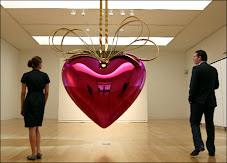.jpg)
